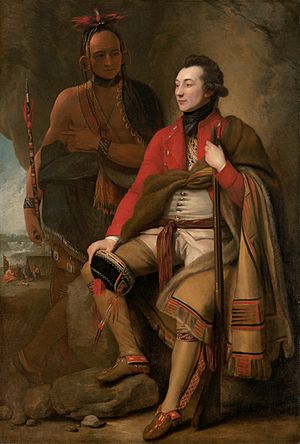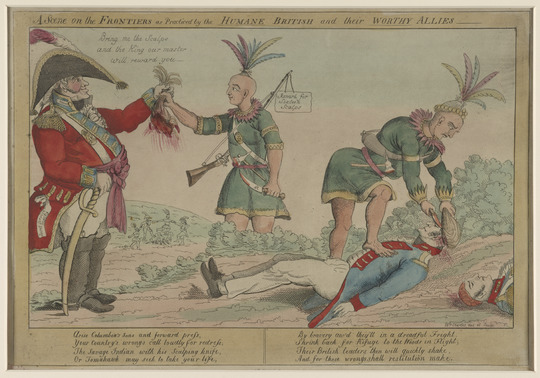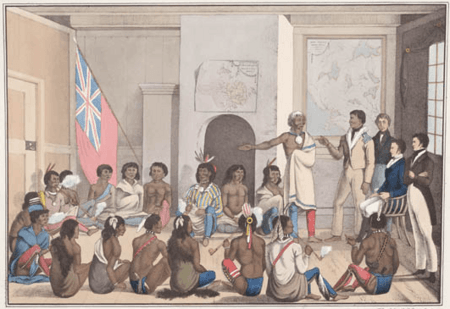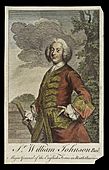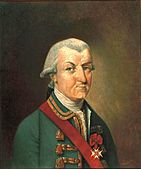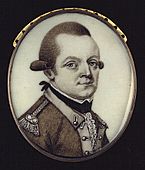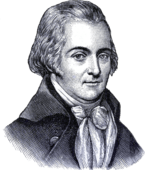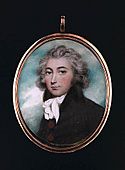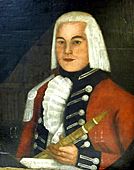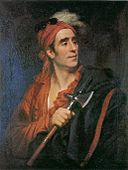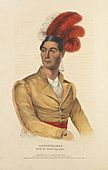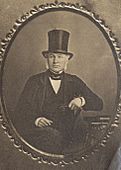British Indian Department facts for kids
Quick facts for kids The British Indian Department |
|
|---|---|
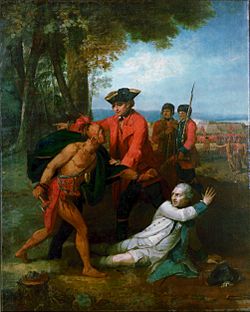
Sir William Johnson at the Battle of Lake George (1755)
|
|
| Active | 1755–1860 |
| Country | |
| Role | Diplomacy Guerrilla warfare Reconnaissance |
| Engagements | Seven Years' War (1755-1760) Pontiac's War (1763-1765) Revolutionary War (1775-1782) Northwest Indian War (1785-1795) War of 1812 (1811-1815) Canadian Rebellion (1837-1838) |
| Commanders | |
| Notable commanders |
Sir William Johnson Captain Joseph Brant Sir John Johnson Major John Norton |
The British Indian Department was a special group created in 1755 by the British Empire. Its main job was to manage relationships between the British and the First Nations (Indigenous peoples) in North America. This department played a big role in both diplomacy and military actions. It helped with things like justice, managing the fur trade, and even hiring blacksmiths and teachers. When there was trouble or war, the department also helped organize and lead Indigenous warriors.
The most important British leader in North America, like the Commander-in-Chief or the Governor General, was officially in charge of the Indian Department. But often, the department's own senior officers made most of the decisions. They were the experts, and the Governors General usually listened to their advice. In 1860, the British government handed over control of the department to the Province of Canada. This eventually led to the creation of today's Department of Crown–Indigenous Relations and Northern Affairs Canada.
Contents
What Was the Department's Purpose?
Protecting Indigenous Rights (1755-1830)
From 1755 to 1830, the Indian Department had several important goals:
- Protecting Indigenous peoples: They aimed to stop traders and land buyers from taking advantage of Indigenous communities. This was a key goal of the Royal Proclamation of 1763.
- Negotiating land boundaries: They worked with First Nations to agree on borders between their lands and those of the colonists. An example is the Treaty of Fort Stanwix in 1768.
- Distributing gifts: The British government gave gifts to Indigenous peoples to build good relationships. The department made sure these gifts were given out fairly. Even First Nations living in what became American territory received gifts until 1830.
- Seeking military support: During wars, the department tried to get First Nations to help Britain as allies. For example, during the War of 1812, they worked closely with Chief Tecumseh.
Managing Reserves (1830-1860)
After 1830, the department's main job changed. It focused on managing the Indian Reserves. These were specific areas of land set aside for Indigenous communities.
How Was the Department Organized?
Who Was in Charge?
At first (1755-1796), the Indian Department reported to the Home Office in London, even though the British Commander-in-Chief in North America gave them instructions. Later, different parts of the department reported to local governors. For example, in 1796, the department in Upper Canada reported to its Lieutenant Governor. In 1800, the Governor General became responsible for the department in Lower Canada.
In 1816, the entire department in both Upper and Lower Canada was placed under the British Commander-in-Chief. It was divided again in 1830 but then merged back together in 1840, reporting to the Governor General.
How Was the Department Structured?
In 1755, the department was split into two main parts: the Northern Department and the Southern Department. Each had its own superintendent. The Ohio River and the Potomac River formed the boundary between them. During the American Revolutionary War, the Southern Department was even further divided.
After the Treaty of Paris in 1783, which ended the American Revolution, the department's work focused only on Canada. The two departments officially became one. The top position, "superintendent," was removed in 1844. After that, the Governor-General's Civil Secretary directly led the department.
Key Moments in the Department's History
Early Years (1755-1774)
Before 1755, each British colony handled its own relationships with Indigenous nations. But when the Seven Years' War began, Britain decided it needed a central way to manage these important relationships. So, in 1755, Sir William Johnson was given a special job as Superintendent of Indian Affairs. His goal was to get Indigenous warriors to fight alongside the British against New France and to convince other Indigenous groups to stay neutral or join the British.
Sir William Johnson led the Northern Department, which worked with Indigenous peoples living north of the Ohio River. He held this position until he passed away in 1774. His son-in-law, Guy Johnson, took over until 1782. For the Southern Department, Edmond Atkins was the first superintendent in 1756, followed by John Stuart in 1762.
The American Revolution (1775-1782)
During the War of the American Revolution, the Indian Department became a very strong military force for the British. Many Indigenous communities were upset with the American settlers who were rebelling. This made them natural allies for the British. Joseph Brant, a famous Mohawk leader, became a captain in the Indian Department during this war. His sister, Molly Brant, also played a very important role and later received a pension from the British government for her help.
Fighting in New York and Ohio
- Northern Frontier: The fighting was especially harsh in northern New York, which was the homeland of the Six Nations. Sir John Johnson and John Butler were active members of the Indian Department here. After a major British loss at the Battle of Saratoga in 1777, the war in this area became mostly about quick, violent attacks. In 1778, the British Indian Department and its allies won important battles like the Battle of Wyoming and the Raid on Cherry Valley. In 1779, American forces destroyed many cornfields and villages of the Six Nations. In response, Sir John Johnson and his Indigenous allies carried out a large raid in 1780, known as the Burning of the Valleys.
- Ohio Country: The Indian Department also fought a lot in the Ohio Valley region. Leaders like Alexander McKee, Matthew Elliott, and Simon Girty were very effective British supporters. Major battles involving the department here included Captain Bird's Invasion of Kentucky, Crawford's Defeat, and the Battle of Blue Licks. The department was especially good at getting warriors to fight against the Americans after the massacre at Gnadenhutten in 1782, where 96 peaceful Christian Munsees were killed by American militiamen.
After the Revolution (1782-1812)

After the Revolutionary War, Guy Johnson was removed from his leadership role. His brother-in-law, Sir John Johnson, took over and led the department for almost 50 years until his death in 1830.
Northwest War and Jay's Treaty
For a long time after the Revolution, the Indian Department was very concerned about the ongoing conflict between Indigenous communities in the Ohio Valley and the new American Republic. In the 1790s, this conflict grew into the Northwest Indian War. Even though the Indian Department quietly supported the Indigenous warriors, the British Empire never openly joined the fight. At the Battle of Fallen Timbers in 1794, the Northwestern Confederacy was defeated, which led to the Treaty of Greenville in 1795.
After the American victory, the Jay's Treaty was signed between the United States and Britain in 1796. This treaty said that the British, including the Indian Department, had to leave their forts on American land. However, it also had a special rule allowing Indigenous peoples to freely cross the new border. This rule meant the Indian Department could keep strong connections with Indigenous communities living in U.S. territory, such as the Shawnee and the Dakota.
Moving to Canada
After the Revolutionary War and again after Jay's Treaty, many members of the Indian Department moved from their homes in what is now the United States to Canada. They became known as Loyalists. Sir John Johnson became a key figure in the Montreal area, and Alexander McKee helped found settlements in western Upper Canada. The movement of the Six Nations of the Grand River with Joseph Brant and the Mohawks of the Bay of Quinte with John Deseronto to the Province of Quebec was part of this big move.
A separate leader for the Indian Department in Upper Canada, called the Deputy Superintendent General, was created in 1794. Alexander McKee was the first, followed by William Claus in 1799.
The War of 1812 (1812-1815)
The Indian Department was very important again in the War of 1812. It helped organize warriors to fight the United States in many battles. The department was especially helpful in supporting the movement led by Tenskwatawa, the Shawnee Prophet, and his brother Tecumseh. Many department members, like George Ironside Sr. and Matthew Elliott, even had family ties to the Shawnee. Other important members during this war included Joseph Brant's son, John Brant, and his adopted heir, John Norton.
During the War of 1812, the Indian Department got its first official uniform: a red jacket with green on the collar and cuffs.
One of the main goals for the British Indian Department and its First Nations allies was to create an Indian barrier state. This would be an Indigenous homeland in American territory, free from American settlers, and would also act as an extra defense line for British Canada. The defeat of Tecumseh's forces at the Battle of the Thames in 1813 was a big setback for this plan. However, even after this, the Indian Department and its Indigenous allies won important victories, such as the Battle of Michilimackinac and the Siege of Prairie du Chien in 1814.
Treaty of Ghent
During the war, the British Indian Department had promised that First Nations would not be forgotten in any peace treaty with the United States. But the Treaty of Ghent, which ended the war in 1815, did not include any plans for an Indian barrier state. Just like after the Treaty of Paris in 1783, the Indigenous communities who had fought as British allies were left without their promised land. Many members of the British Indian Department were very upset by this betrayal.
After the War (1815-1860)
Because the Indian Department had become so important militarily after the War of 1812, its separate branches in Upper and Lower Canada were brought back together under military control in 1816. In 1830, it was divided again. In Upper Canada, Lieutenant Governor Sir John Colborne appointed James Givins to lead the Upper Canadian branch. In Lower Canada, Duncan Campbell Napier became the senior member after Sir John Johnson's death in 1830.
During the Rebellions of 1837–1838, the Indian Department once again helped organize warriors to stop internal uprisings and invasions from American territory.
Transfer to Canadian Government
In 1841, Upper and Lower Canada joined to form the Province of Canada. The Governor General then took direct control of the Indian Department. However, his secretary usually handled the daily tasks. This continued until 1860, when the British government officially handed over responsibility for the Indian Department to the government of the Province of Canada. In the 15 years before this transfer, many old practices of the department were stopped, especially the yearly giving of gifts to Indigenous communities allied with the British Crown.
Gallery of Prominent Members
-
Superintendent General William Johnson (c. 1715-1774)
-
Superintendent General Sir John Johnson (1741-1830)
-
Deputy Agent John Butler (1728-1796)
-
Superintendent Thomas McKee (c. 1770-1814)
-
Major John Norton (c. 1770 - c. 1830)
-
Superintendent John Brant (1794-1832)


